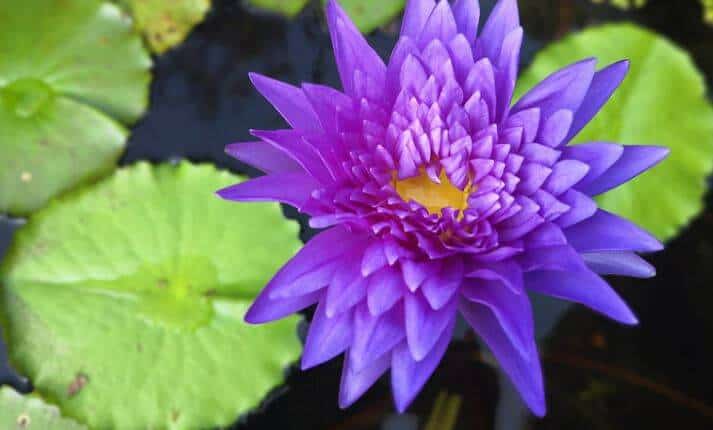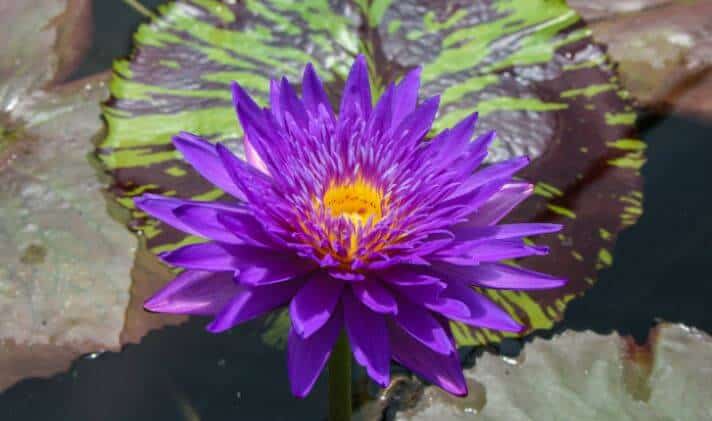Last Updated on January 6, 2023 by a Friendly Gardener
The tropical water lily is stunningly beautiful, big, and brightly colored making her the queen of your home pond. They require very little care needing occasional feeding and a little pruning from time to time. Aside from their beauty, they also provide cover for the fish in your pond. Available in a wealth of colors, they must have a warm climate for survival.
Referred to as the tropicals, these lily plants belong to the Nymphaeaceae family with nine genera and approximately 70 recognized species. They hate cold weather and will die off as winter rolls around.
Unusual colors, unique shapes, and eye-catching leaves all add to their allure. Tropical water lilies can be admired in pinks, purples, and even shades of blue. The tropical water lily’s appearance is similar to a large sunburst with stems growing between 6 and 12 inches in length. Tropical water lilies have lily pads for foliage. Some may have serrated edges. Leaf color can grow in colors from chartreuse and purple to burgundy with yellow variegation.
These plants are prolific in flowering with 3 to 5 blooming simultaneously and a few may bloom at night remaining open to just after dawn. With a varied selection of lily cultivars, you could enjoy blooming 24 hours a day! A sweet fragrance characterizes their presence in the pond. What’s even better is that they will last into autumn until the cold finally arrives.
Hardy Water Lilies vs. Tropical Water Lilies

There are two kinds of water lilies used in pond cultivation: hardies and tropicals. Hardy water lilies are grown from rhizomes. Each rhizome develops bumps that develop into new plants. Tropical water lilies instead grow from bulbs, that in turn produce baby bulbs that can be separated and replanted. Tropical water lilies also emanate a sweet fragrance that hardies do not.
However, the principal difference between the two is the cold. While hardy water lilies will tolerate cold, tropicals despise it. Both water lily types will enter dormancy in colder temperatures, but hardies can tolerate temperatures that dip to just above freezing water solid. In warm climates, tropical water lily bulbs can remain in the water. In cold temperatures, they should be removed and stored in cool to warm, moist conditions.
Other recognizable differences include the sizes of the flowers. Both types are available in dwarf to large variants, but the tropical water lily is generally larger. Tropical foliage is thin and scalloped or serrated while hardies have waxy, thick leaves that are usually a solid green. The Tropical Water Lily Blooms will open well above the water’s surface while the hardies float directly on the water’s surface.
Planting the Tropical Water Lily

Many tropical water lilies are shipped and sold as bare root plants with 3 to 8 leaves. They may also feature some buds or flowers. They may die back due to transplanting but will quickly develop new growth.
Your tropical water lily will produce large vividly colored flowers when exposed to full sunlight. They should ideally be submerged in 12 to 24 inches of water, although they will bloom fine in a minimum of 8 inches to a maximum of 30 inches of water. Both leaves and flowers can be entirely submerged because as they grow, they will find their way to the water’s surface. They should not be placed near fountains or waterfalls as they ideally need still water
When placing tropical water lilies in the pond, you can do so while still in the container it arrives in. Place a bit of gravel on the lily container surface to keep the soil from floating out. Your other options are placing it directly in the pond without the container or replanting your flower in a fabric plant pot. Should you choose a fabric container, roots will have more room to spread out. Place the flower and soil in the fabric pot, adding a bit of gravel to the top. Place your fabric pot into the water at an angle to help the soil remain in the container.
Planting the lily directly in the pond is also an option if your pond has gravel on the bottom. Remove the flower and dirt from the lily’s tuber. Place the tuber in the gravel and cover it enough so that it remains in place.
Should some dirt end up in your pond, use a skimmer to remove it.
An alternative to soil is to use clay cat litter blended with some sand. It’s important that the litter is not chemically treated.
Tropical Lily Plant Care

Feeding the Tropical Water Lily
Tropical water lilies need to be fed monthly for their entire life. It’s easiest to use fertilizer tabs pressed into the soil around the plant’s base.
Pruning a Tropical Water Lily
Water lilies open at one time daily and close at a different time. This blooming cycle will continue for 3 to 5 days before the flower dies. A clue to the end of the blooming cycle is when the water lily sinks to the pond bottom underwater. Once the lily sinks it will not bloom again. This is when you should prune the flower. Trim off the flower and stem back to the plant’s base.
Prune off yellowing foliage in the same manner. By removing spent blooms and leaves, your plant will channel its energy to new blooms and leaves.
The Tropical Lily’s Flowering Season

With adequate sunlight exposure and a monthly feeding, your lily will produce numerous blooms during its flowering season which generally runs from May through October. A few may continue a bit longer.
This plant will not survive outside in the winter season unless you live in the southernmost United States. If this is not the case, remove your lily plant from your pond when it appears to have completed its cycle. Some home water gardeners choose to overwinter lilies by bringing them indoors, while others cultivate them as annuals, composting them at the end of the season.
Tropical Water Lily Propagation

Tropical Water Lilies can be propagated using their tubers. Tubers will produce new growths. When these develop visible roots, they can be removed. These new baby plants will eventually develop their own tuber. Plantlets should have an adequate root system to sustain their growth. Plantlets should be pinched off the parent tuber just below the where plantlet and the roots are joined. New plantlets can be potted and then placed in the pond to grow.
A Final Thought
These lovely aquatic plants are easily the most popular of water garden plants. They protect the fish in your pond from predators and direct sun exposure. The Tropical Water Lily offers an amazing palette of colors to choose from, with a generous number of blossoms, and a lovely, sweet smell for your pond area.

